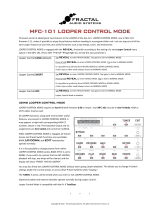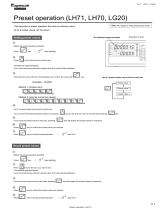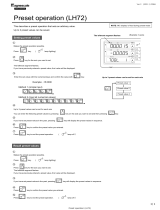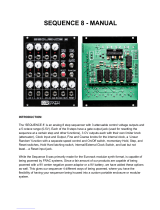Page is loading ...

Tête + Tetrapad Manual
Tête + Tetrapad
Recordable, Syncable, Multi-Dimensional Performance Touch Controller
IMPORTANT!
This manual discusses Tête and Tetrapad when the two are used together. Tetrapad, when used
without Tête, operates significantly different and has its own dedicated manual.
Manual Revision: 2019.12.11

Tête + Tetrapad Manual
TABLE OF CONTENTS
TABLE OF CONTENTS 1
COMPLIANCE 7
PART ONE: INSTALLATION 8
INSTALLATION 9
Installing Your Modules 9
Connecting Tête to Tetrapad 11
Setting Tetrapad’s DIP Switches 11
The microSD Card 12
PART TWO: OVERVIEW 13
OVERVIEW 14
TETRAPAD PANEL OVERVIEW 16
Tête PANEL OVERVIEW 19
Outputs 19
Inputs & Attenuverters 20
Controls 25
MODE OVERVIEW 27
PART THREE: COMBO MODE 28
COMBO MODE 29
Entering Combo Mode 31
Assigning a Function to a Pad 31
Main Screen & Menus in Combo Mode 33
Combo Mode: Unipolar Fader 34
Assigning Unipolar Fader Functionality To A Pad 35
Using Unipolar Faders 36
Slew Between Fader Settings 37
Page 1

Tête + Tetrapad Manual
Quantizing Fader Values 37
Combo Mode: Bipolar Fader 38
Assigning Bipolar Fader Functionality To A Pad 39
Using Bipolar Faders 40
Slew Between Fader Settings 41
Quantizing Fader Values 41
Combo Mode: Crossfader 42
Assigning Crossfader Functionality To A Pad 43
Selecting a Crossfader Type 44
Using Crossfaders 46
Slew Between Fader Settings 47
Combo Mode: Euclidean 48
Assigning Euclidean Functionality To A Pad 49
Using Euclidean Pads 50
Creating & Rotating Syncopated Patterns 52
Using Euclidean Pads as Simple Drum Pads 53
Slew Between Vertical Output Voltages 54
Quantizing Vertical Output Voltages 54
Combo Mode: Switches 55
Assigning Switch Functionality To A Pad 56
Using Switches 57
Combo Mode: LFO 58
Assigning LFO Functionality To A Pad 59
Using an LFO (Overview) 60
LFO Basics 60
Locking the LFO Rate 61
Attenuating the LFO Output 61
Unipolar, Bipolar and Quantized LFOs 62
Page 2

Tête + Tetrapad Manual
PART FOUR: NOTES MODE 63
NOTES MODE 64
Entering Notes Mode 66
Setting the Number of Virtual Keys 67
Tuning Mode 68
Choosing a Note Assignment Method 68
Set Notes by Scale 69
Assigning Notes to the Tetrapad ‘Keyboard’ w/Scale 71
Playing the Keyboard 72
Slew Between Notes 74
Set Notes by Chord 75
Assigning Notes to the Tetrapad ‘Keyboard’ w/Chord 77
Playing Chords 78
Slew Between Chords 79
Copying & Pasting Chords 79
Set Notes Manually 80
Assigning Notes to the Tetrapad ‘Keyboard’ Manually 82
Playing the Keyboard 83
Slew Between Notes 83
Rotating and Inverting 83
Copying & Pasting Notes 84
Edit View for Notes Mode 85
PART FIVE: VOLTAGES MODE 86
VOLTAGES MODE 87
Entering Voltages Mode 88
Setting the Number of Voltage Banks 89
Assigning Voltage Values 89
Manual Voltage Assignment 89
Random Voltage Assignment 91
Reset a Voltage 92
Page 3

Tête + Tetrapad Manual
Slew Between Voltages 92
Quantizing Voltage Values 92
Edit View for Voltages Mode 93
Copying & Pasting Voltage Banks 94
PART SIX: MENUS 95
MENU OVERVIEW 96
MODE Select Menu 97
Mode SETUP Menu 97
Combo Mode SETUP Menu 98
Notes Mode SETUP Menu 102
Voltages Mode SETUP Menu 105
Global Setup Menu 108
System Mode 109
CV Setup Menu 110
CV Setup: SYNC Output 111
CV Setup: Output A 112
CV Setup: Output B 112
CV Setup: TRIG and RESET Inputs 113
CV Setup: RESET Input 114
CV Setup: Input X, Y and Z (Notes Mode) 115
CV Setup: Input X, Y and Z (Voltages Mode) 119
CV Setup: Input X, Y and Z (Combo Mode) 126
Load Defaults 131
FILE Menu 132
TEMPO Menu 134
Page 4

Tête + Tetrapad Manual
PART SEVEN: LOOPING & SEQUENCING 135
THE LOOPER 136
Combo Mode Looping 137
Record & Play with Touch Sync 138
Record & Play with Looper Sync 140
Record & Play Unsynced 142
Overdubbing 143
The Encoder Bar (In Looper) 144
Combo Mode Encoder Bar (Looper) 144
Notes Mode Encoder Bar (Looper) 144
Voltages Mode Encoder Bar (Looper) 145
Save, Load, Rename and Delete Loops 146
THE SEQUENCER 147
Record & Play A Note Sequence 147
Recording a Note Sequence 148
Playing Back a Note Sequence 149
Record & Play A Voltage Sequence 150
Recording a Voltage Sequence 151
Playing Back a Voltage Sequence 152
Editing Sequences 153
Appending Sequences 153
Overwriting Sequences 154
Inserting Into Sequences 154
Overdubbing Sequences 155
Save, Load, Rename and Delete Sequences 156
Page 5

Tête + Tetrapad Manual
LOOPY 157
Loopy with Sequences 157
Loopy Length with Sequences 158
Loopy Shift with Sequences 158
Position Sync with Sequences 159
Loopy with Loops 161
Loopy Shift with Loops 162
Position Sync with Loops 163
PART EIGHT: MISCELLANEOUS 164
CALIBRATION 165
Calibrating Tête 165
Calibrating Tetrapad 167
FIRMWARE VERSION DISPLAY 170
Displaying Tetrapad Firmware Version on Tête 170
Displaying Tetrapad Firmware Version on Tetrapad 170
Version 3 Firmware Display Method 170
Version 1 & 2 Firmware Display Method 171
FIRMWARE CHANGE LOG 172
TECHNICAL SPECIFICATIONS 172
Page 6

Tête + Tetrapad Manual
COMPLIANCE
This device complies with Part 15 of the FCC Rules. Operation is subject to the
following two conditions: (1) this device may not cause harmful interference, and
(2) this device must accept any interference received, including interference that
may cause undesired operation.
Changes or modifications not expressly approved by Intellijel Designs, Inc. could
void the user’s authority to operate the equipment.
Any digital equipment has been tested and found to comply with the limits for a
Class A digital device, pursuant to part 15 of the FCC Rules. These limits are
designed to provide reasonable protection against harmful interference when the
equipment is operated in a commercial environment. This equipment generates,
uses, and can radiate radio frequency energy and, if not installed and used in
accordance with the instruction manual, may cause harmful interference to radio
communications.
This device meets the requirements of the following standards and directives:
EMC: 2014/30/EU
EN55032:2015 ; EN55103-2:2009 (EN55024) ; EN61000-3-2 ; EN61000-3-3
Low Voltage: 2014/35/EU
EN 60065:2002+A1:2006+A11:2008+A2:2010+A12:2011
RoHS2: 2011/65/EU
WEEE: 2012/19/EU
Page 7

Tête + Tetrapad Manual
PART ONE:
INSTALLATION
Page 8

Tête + Tetrapad Manual
INSTALLATION
Intellijel Eurorack modules are designed to be used with a Eurorack-compatible case and power
supply. We recommend you use Intellijel cases and power supplies.
Before installing these modules in your case, you must ensure your power supply has a free power
header and sufficient available capacity to power the modules:
● Sum up the specified +12V current draw for all modules, including the new ones. Do the same
for the -12 V and +5V current draw. The current draw will be specified in the manufacturer's
technical specifications for each module.
● Compare each of the sums to specifications for your case’s power supply.
● Only proceed with installation if none of the values exceeds the power supply’s specifications.
Otherwise you must remove modules to free up capacity or upgrade your power supply.
You will also need to ensure your case has enough free space (hp) to fit the new modules. To prevent
screws or other debris from falling into the case and shorting any electrical contacts, do not leave
gaps between adjacent modules, and cover all unused areas with blank panels. Similarly, do not use
open frames or any other enclosure that exposes the backside of any module or the power distribution
board.
You can use a tool like ModularGrid to assist in your planning. Failure to adequately power your
modules may result in damage to your modules or power supply. If you are unsure, please contact us
before proceeding.
Installing Your Modules
When installing or removing modules from your case
always turn off the power to the case and disconnect
the power cable. Failure to do so may result in
serious injury or equipment damage.
Ensure the 10-pin connector on the power cable is
connected correctly to each module before
proceeding. The red stripe on the cable must line up
with the -12V pins on the module’s power connector.
Different modules use different ways to indicate the
-12V pins. Some may be labelled with “-12V;” a white
stripe next to the -12V pins; the words “red stripe;” or
some combination of these. Additionally, some
modules may have shrouded headers, thus
preventing backward connections.
Page 9

Tête + Tetrapad Manual
Most modules will come with the cable already connected but it is good to double check the
orientation. Be aware that some modules may have headers that serve other purposes so ensure the
power cable is connected to the right one.
The other end of the cable, with a 16-pin connector,
connects to the power bus board of your Eurorack
case. Ensure the red stripe on the cable lines up
with the -12V pins on the bus board. On Intellijel
power supplies the pins are labelled with the label
“-12V” and a thick white stripe:
If you are using another manufacturer’s power
supply, check their documentation for instructions.
Once connected, the cabling between each module and power supply should resemble the picture
below:
Before reconnecting power and
turning on your modular system,
double check that the ribbon cable
is fully seated on both ends and
that all the pins are correctly
aligned. If the pins are misaligned in
any direction or the ribbon is
backwards you can cause damage
to your module, power supply, or
other modules.
After you have confirmed all the
connections, you can reconnect the
power cable and turn on your
modular system. You should
immediately check that all your modules have powered on and are functioning correctly. If you notice
any anomalies, turn your system off right away and check your cabling again for mistakes.
Page 10

Tête + Tetrapad Manual
Connecting Tête to Tetrapad
IMPORTANT
: Tetrapad must be running version 3.0 firmware or higher. See
Firmware Version
Display
.
After connecting both the Tête and Tetrapad to power, you will need to connect the two modules to
each other. This is done using the included, small 6-wire i2C cable.
1. Connect one end of the cable to either of the two i2C 6-pin connectors on the back panel of
your Tetrapad, being sure to orient the red line with the white stripe on the circuit board. It
doesn’t matter which of Tetrapad’s two i2C connectors you use.
2. Connect the other end of the cable to either of the two shrouded i2C 6-pin connectors on the
back panel of your Tête. The connector is designed in such a way that it can only connect one
way. It doesn’t matter which of Tête’s two i2C connectors you use.
Setting Tetrapad’s DIP Switches
As shown in the illustration above, you will also need to configure some DIP switches on the back of
your Tetrapad in order for it to work with Tête. Specifically:
● Make sure DIP switches 1 (SDA) and 2 (SCL) are set to the ON position.
● Make sure DIP switches 3 (ID1) and 4 (ID0) are set to the OFF position.
Page 11

Tête + Tetrapad Manual
The microSD Card
Tête ships with a 16GB Class 10, FAT32 microSD card pre-installed on the rear circuit board, which is
used for storing patches, loops, sequences and various settings.
This card has been verified and tested by Intellijel, and is the only officially supported card, though it’s
possible others might work. One important caveat is that larger cards often have slower read times, so
proceed with caution — particularly if using a larger microSD card.
If you choose to install a different card and Tête is unable to read it, then Tête will automatically format
it to FAT32, and place all related files within a Tête folder on the root of the card.
Page 12

Tête + Tetrapad Manual
PART TWO:
OVERVIEW
Page 13

Tête + Tetrapad Manual
OVERVIEW
Tetrapad is a versatile, multi-dimensional, touch-sensitive control surface for Eurorack. Each of its four
pads use force sensing resistors to respond to both the vertical position of your finger and its
pressure. Four push encoders and a shift function give you even more tactile control over your
modular system.
Tête connects directly to the Intellijel Tetrapad module — enhancing and expanding upon its
capabilities; adding additional inputs, outputs, CV control, clocking, sequencing, looping, and many
more features and modes.
IMPORTANT!
When Tête and Tetrapad are connected, they function as a single entity, controlled and
configured by Tête. Tetrapad becomes “just” a control surface and Tête provides all the
“smarts.” None of the modes or configuration techniques discussed in the standalone
Tetrapad manual apply when a Tête is connected, since Tête controls all Tetrapad
functionality.
Tête requires a Tetrapad with firmware version 3.0 or higher. See Firmware Version Display to
see how to check its firmware. Should any updates be needed, you can download them (along
with update instructions) from the Intellijel.com website.
If you are using Tetrapad without Tête, please read the dedicated standalone Tetrapad manual
instead.
Tête takes control of Tetrapad’s mode selection and operating functions, allowing Tetrapad to do what
it does best — act as a control surface, which it does both for controlling external modules and for
interfacing with the advanced processing power within Tête.
Tête + Tetrapad operates in one of three different modes:
● Combo: In this mode, you may assign each of Tetrapad’s four pads to its own independent
function, such as: a fader; a bi-polar fader; a crossfader; LFO; a dual switch; or a finger
drumming/euclidean rhythm pad. The chosen function determines the type of signal (CV, note,
trigger, gate, etc.) sent from each of Tetrapad’s eight independent outputs, while its multitude
of multi-colored LEDs keep you informed of exactly what’s happening within each mode.
● Notes: This mode divides Tetrapad’s four pads into 4, 8, 12, or 16 zones. Each zone is like a
key on a keyboard, and can be user-configured (manually, by scale, or by chord) to output
different notes to four different outputs.
Page 14

Tête + Tetrapad Manual
● Voltages: This mode divides Tetrapad’s four pads into 8, 12, or 16 zones. Each zone is a
voltage storage bank, which sends 8 different memorized voltages to Tetrapad’s eight outputs.
Besides taking control of (and expanding) Tetrapad’s Mode assignment features, Tête offers the
following additional capabilities:
● Step-recording (Sequencing) Tetrapad performances of up to 256 steps.
● Real-time recording (Looping) of Tetrapad performances. Although technically limited only by
the size of the microSD card, Tête’s interface is optimized for dealing with recordings less than
5 minutes.
● Loopy performance mode in both the Looper and Sequencer, for repetitive stutter effects or
even granular-level looping.
● Dedicated transport controls.
● External voltage control of Tête/Tetrapad with three user-assignable CV inputs (each with
dedicated attenuversion), two user-assignable gate/trig inputs, and a dedicated clock input.
● Clockable either internally or to an external clock, with full clock division and multiplication
capability.
● Three additional user-assignable CV outputs.
● Visual representation of Tetrapad functions via its built-in screen
● Ability to split pads into 2, 3 or 4 zones, enabling up to 16 possible voltage banks or a 16 note
virtual “keyboard.”
● 99 User-presets for each Mode (Combo, Notes, and Voltages), each of which stores all the
Mode Setup parameters; Tête’s CV Assignments, and an associated Sequence or Loop.
Tête automatically remembers how you last configured it, and retains these settings when powered
off. By default, Tête automatically and instantly saves its state whenever you make a change. This
makes Tête + Tetrapad ideal for live performance, since you know it will always power up with your
configurations intact. There is only one exception: if the looper or sequencer is currently playing, then
Tête waits for playback to stop before saving its state, so that maximum attention is given to the timing
and playback of your loop or sequence.
Page 15

Tête + Tetrapad Manual
TETRAPAD PANEL OVERVIEW
Below is a general overview of Tetrapad’s front panel. Each of these features will be discussed in
detail later in the manual.
1. Pads 1-4
Four identical touch strips, each of
which is sensitive to both vertical
position and finger pressure.
Depending on the current mode,
these pads can transmit trigger
signals, gate signals, quantized
note values or real-time control
voltages.
2. Level LEDs
Embedded beneath the surface of
each pad is a 12 LED ladder. This
ladder displays different parameter
values in different modes. When
operating as a basic fader, the
LEDs represent the fader’s level;
when operating as note triggers,
they represent the note
assignment; when selecting
modes, they display Combo Mode
animations.
3. Push Encoders 1-4
Each of the four pads has its own associated push encoder, which functions differently
depending on the current mode. For example, if Tête + Tetrapad is in Notes Mode, the
encoders assign note values for each output. In Voltages Mode, the encoders assign voltage
values to an output. Similarly, pressing the encoder has different functions depending on the
mode. For example, if you’ve assigned a fader to a pad in Combo Mode, pressing an encoder
latches that fader’s value.
Page 16

Tête + Tetrapad Manual
4. Pad Status LEDs 1-4
Some modes use these LEDs to
indicate a pad’s status. For
example, they may indicate
whether or not a pad’s fader level
is latched; or the octave to which a
note is assigned.
5. Level Labels
This vertical column of text
provides meaningful labels to each
of the 12 vertically stacked Level
LEDs. On the right are note
names, which indicate pitch when
appropriate to the selected mode.
On the left are numbers 1-12 for
indicating numerical values.
6. EDIT Button
This button has various functions
depending on which mode is
active.
In Combo Mode, it enables you to
assign different functions to different pads on Tetrapad.
In Notes Mode, it’s employed by various copy & paste operations, and in Voltages Mode, it
randomizes and resets all output voltages (when used in combination with the SHIFT button).
NOTE: The button has other functions when Tetrapad operates as a standalone module.
7. SHIFT Button & LED
Some modes offer additional features and parameters, accessible by pressing the SHIFT
button. Depending on the chosen mode, the SHIFT button may be used for setting slew rates,
assigning output voltage ranges, or quantizing the CV output of a pad. See the individual mode
discussions to learn whether or not the SHIFT button is used, and what functions it serves.
The LED immediately above the SHIFT button glows red whenever a shift feature is engaged.
8. Outputs 1-8
Outputs CV, pitch, gate or trigger signals depending on the active mode. See the detailed
Modes sections to learn the function of each jack in each mode.
Page 17

Tête + Tetrapad Manual
9. Output Status LEDs
In general, the color of these LEDs
glow solid and indicate the type of
signal appearing at the output jack
for the active mode. See the table
below.
When using Tetrapad, an Output
Status LED’s brightness (as well
as its color) can provide useful
status information. For example, a
green (vertical position) LED gets
brighter when your finger is higher
up the pad; a cyan (pressure) LED
gets brighter the harder you press
a pad; Other modes make
additional use of these status
LEDs, and will be discussed in the
corresponding sections.
Blue
Pitch CV
Magenta
Gate/Trigger
Green
Positive Voltage
(May indicate vertical position or LFO level)
Red
Negative Voltage
(May indicate vertical position or LFO level)
Cyan
Pressure
Page 18

Tête + Tetrapad Manual
Tête PANEL OVERVIEW
Below is a general overview of Tête’s front panel. Many of these features will be discussed in greater
detail in the appropriate sections of the manual.
Outputs
1. SYNC OUT
By default the SYNC OUT jack is assigned to the
“EOL/EOS” function (for all modes), which outputs a +5V
trigger at the end of the currently playing loop or
sequence.
However, you can override the default output function for
each mode using the CV Setup Menu, accessed by
pressing the CV FILE button [D].
Numerous assignments are possible, including:
EOL/EOS; SOL/SOS, Touch, Run, Clock, etc. See
CV Setup: SYNC Output for a description of all the
possible options.
2. A OUT
By default the A OUT jack is assigned to the “Loop
Position” function (for all modes), which outputs a
voltage that rises steadily from 0V (at the beginning of a
loop or sequence) to +5V at the very end of the currently
playing loop/sequence.
However, you can override the default output function for
each mode using the CV Setup Menu, accessed by
pressing the CV FILE button [D].
Numerous assignments are possible, including: Clock,
Run Clock, Touch Clock, Play, Stop, Run, EOL/EOS,
SOL/SOS, Touch and Loop Position. See CV Setup:
Output A for a description of all the possible options.
Page 19
/



